Office of Naval Research - National Transportation Library
Office of Naval Research - National Transportation Library
Office of Naval Research - National Transportation Library
You also want an ePaper? Increase the reach of your titles
YUMPU automatically turns print PDFs into web optimized ePapers that Google loves.
Section 3.0 Market Conditions, Service Requirements andPotential Market Size for Viable SSS Service3-1 Baseline Commodity Market CharacteristicsThe composition <strong>of</strong> the domestic cargo shipped in the U.S. waterborne commerce ismarkedly different from the composition <strong>of</strong> cargo shipped in international trade. The U.S.domestic waterborne cargo trade is largely dominated by dry and liquid bulk products.Eighty five percent <strong>of</strong> the 1 billion tons <strong>of</strong> cargo shipped for domestic waterborne commercein 2006 was coal, bulk petroleum, crude materials and chemicals (Figure 19). These productsare transported in dry- or liquid-bulk form in self-propelled tankers, tank barges pulled bytugs, and in dry-bulk barges. Only about 15 percent <strong>of</strong> the domestic waterborne cargo – foodproducts and manufactured equipment – is currently suitable for containerization. Figure 19shows the breakdown <strong>of</strong> the domestic waterborne trade by commodity class.Figure 19 – Domestic Waterborne Commerce by Commodity Group8%PrimaryManufacGoods5%Domestic Waterborne Commerce byCommodity Group, 2006 (1.0 BillionShort Tons)Food/FarmProductsManufacEquipment2%Coal22%Chem&Related21%CrudeMaterials7%Petro&Petro Products35%Volpe generated chart based on IWR, USACE data.Adversely influencing the size <strong>of</strong> the domestic markets for waterborne trade are twointerrelated factors: the low value <strong>of</strong> the bulk cargo carried and the short distances shipped.Together, these two factors explain why the share <strong>of</strong> waterborne domestic cargo transportedin the U.S. is so small.Bulk commodities have lower per-unit cargo value than containerized cargo. Since shippingcharges are ad-valorem, domestic bulk commodities, dry or wet, have traditionally claimed asmall share <strong>of</strong> the transportation revenues. This condition has been further exacerbated whencoupled with large volumes <strong>of</strong> empty containers shipped by water, and increasingly shortershipment distances. Together these factors further stifle the growth <strong>of</strong> markets forwaterborne domestic cargo transportation.ONR SSS Final Report 32
















